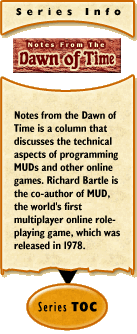To a player, a quest is any non-trivial task that has some definite end and hoped-for reward. Upon completion, it will leave them with a sense of having achieved something.
Many quests grow from players’ own goals and desires: to find the magic armour; to forge the Sword of Destiny; to head up their own temple; to kill every elf in the city. This kind of quest will arise naturally in any game that has enough richness and diversity that players will be able to interact with it without any prompting.
Sometimes, though, players want to be given quests. Although, in theory, they could ask their fellow players for tasks, in practice they’re unlikely to do so because a) the reward will be low, and b) they’re more than likely to be sent to their death, to discourage them from asking again... This being the case, most quests have to be computer-generated.
The way this works is that a player who requires a quest visits a quest-dispenser and presses its button. OK, so this machine may be dressed up as an NPC and the button-pressing may be disguised as conversation, but the basic process is the same. The quest-dispenser gives the player a choice of available quests. Having accepted one (which may involve some behind-the-scenes world changing, eg. by creating an ogre camp nearby) the player must complete it within some time limit. This done, there is either a reward to be collected (“Come back here for 25,000 gold pieces”) or there will be gains intrinsic to the task (“The ogres have a chest containing 25,000 gold pieces that you can keep”).
Computer-generated tasks are either static or dynamic. Static quests are always available: everyone knows what they are, and everyone knows how to solve them. They’re useful because they help draw newbies into the game: people can ask passers-by for help or find the solution on a web site, which means they’re probably going to complete it and thus feel good about themselves. Static quests provide a common, shared experience for a community of players; they act as a rite of passage.
Dynamic quests, on the other hand, are fresh and original. Their uniqueness makes them more exciting, more challenging and more fun. Players can’t get enough of them. Although some are hand-scripted by humans (designers), this is a very costly exercise – particularly given that dynamic quests are only ever effective the first time they’re run. Most quests are therefore computer-generated.
Cookie Cutting for Beginners
The usual way games generate quests is to string together small pieces of story called quest elements. Although humans can connect these together in interesting ways, so that players can become involved in something much wider in scope than they at first envisaged, this doesn’t happen with computer-generated requests (which tend to be arbitrary, pointless affairs). Without a meaningful relationship between the individual quest elements, the whole lacks an overall purpose – yet purpose is precisely what players crave in quests! Computer-generated quests therefore tend to appear only as a single quest element, generated from a basic template.
The result is that computer-generated quests tend to be very unsatisfactory:
- “My cat is trapped in yonder tree”.
Aren’t you more concerned about this army of orcs that’s rampaging through your village burning houses and killing your family?
- “My daughter has been kidnapped by dryads in the woods!”.
Aw, man! I just came back from killing someone else’s dryads in the woods!
- “A dragon is burning our crops!”.
Is that the time? I thought the dragon wasn’t scheduled to burn your crops for another two hours?
- “I seek a rare and precious jewel that was lost in the sands of time...”
Why, exactly?
Human-built quests can involve several steps. “Fetch me object A, fetch me object B and I will give you object C which you will need to kill monster D. Do so, and I will reward you with E.”. They can also be dressed up with background stories so they don’t look so scripted. “There is a sword of troll-slaying in my late father’s tomb, but to open it I need the key that is kept in my wicked uncle’s house and a scroll to remove the protective runes on the lock. Get me these, and you can use the sword to kill the troll who has been slaying the villagers I am sworn to protect. If you perform this service, I shall gratefully tell you the secret of how to cast level 34 lava-class fireballs”.
Humans, though, are expensive – especially creative ones. Furthermore, sitting around all day trying to think of yet another way to say “fetch me this” or “kill me that” is hugely monotonous. Let computers do the mundane work, while the humans work on the intricately plotted webs of intrigue that are completely beyond what computers can currently attempt.
Ah, but the reason that even low-complexity quests have to be hand-crafted is because computers can’t produce anything interesting except by cookie-cutting from a template. They just don’t think like people.
That’s true, but they can appear to think like people.
That’s why I’ve suddenly written about quests four articles into a series on mobile AI.
Next instalment, we’ll finally roll up our sleeves and start looking at how an AI planning engine can be used for something special: generating quests.

